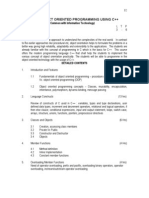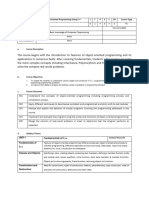Object Oriented Programming Lab 0 0 3 2
Uploaded by
Anjana SudhirObject Oriented Programming Lab 0 0 3 2
Uploaded by
Anjana Sudhir141353
OBJECT ORIENTED PROGRAMMING LAB (Common to CSE & IT)
0 0 3 2
1. Design C++ classes with static members, methods with default arguments, friend functions. (For example, design matrix and vector classes with static allocation, and a friend function to do matrix-vector multiplication) 2. Implement complex number class with necessary operator overloadings and type conversions such as integer to complex, double to complex, complex to double etc. 3. Implement Matrix class with dynamic memory allocation and necessary methods. Give proper constructor, destructor, copy constructor, and overloading of assignment operator. 4. Overload the new and delete operators to provide custom dynamic allocation of memory. 5. Develop a template of linked-list class and its methods. 6. Develop templates of standard sorting algorithms such as bubble sort, insertion sort, merge sort, and quick sort. 7. Design stack and queue classes with necessary exception handling. 8. Define Point class and an Arc class. Define a Graph class which represents graph as a collection of Point objects and Arc objects. Write a method to find a minimum cost spanning tree in a graph. 9. Develop with suitable hierarchy, classes for Point, Shape, Rectangle, Square, Circle, Ellipse, Triangle, Polygon, etc. Design a simple test application to demonstrate dynamic polymorphism and RTTI. 10. Write a C++ program that randomly generates complex numbers (use previously designed Complex class) and writes them two per line in a file along with an operator (+, -, *, or /). The numbers are written to file in the format (a + ib). Write another program to read one line at a time from this file, perform the corresponding operation on the two complex numbers read, and write the result to another file (one per line).
You might also like
- CSE1002 Problem Solving With Object Oriented Programming LO 1 AC39No ratings yetCSE1002 Problem Solving With Object Oriented Programming LO 1 AC397 pages
- Learning Objectives For Computer Science 2No ratings yetLearning Objectives For Computer Science 24 pages
- Faculty of Engineering & Technology First Year Bachelor of Engineering Course Code: 102000212 Course Title: Object Oriented ProgrammingNo ratings yetFaculty of Engineering & Technology First Year Bachelor of Engineering Course Code: 102000212 Course Title: Object Oriented Programming5 pages
- Bca-Hc-4036: Object Oriented Programminf in C++No ratings yetBca-Hc-4036: Object Oriented Programminf in C++4 pages
- Lab Cycle BCA II Semester Course Code: 15CSA191 Course Title: Object Oriented Programming Using C++ Lab Lab Cycle 1No ratings yetLab Cycle BCA II Semester Course Code: 15CSA191 Course Title: Object Oriented Programming Using C++ Lab Lab Cycle 13 pages
- Object Oriented Programming Using C++ 22CSH-103 HybridNo ratings yetObject Oriented Programming Using C++ 22CSH-103 Hybrid6 pages
- Complete The Following List of Program For Practical FilesNo ratings yetComplete The Following List of Program For Practical Files4 pages
- Cse2001 Object-Oriented-programming-with-c++ LTP 1.0 1 Cse2001No ratings yetCse2001 Object-Oriented-programming-with-c++ LTP 1.0 1 Cse20014 pages
- Ita3001 Object-Oriented-programming Eth 1.0 37 Ita3001No ratings yetIta3001 Object-Oriented-programming Eth 1.0 37 Ita30013 pages
- Gujarat Board Computer Science Class 12-SyllabusNo ratings yetGujarat Board Computer Science Class 12-Syllabus2 pages
- Assignment List MCA-2nd Year (IIIrd Sem) OPPs With C++No ratings yetAssignment List MCA-2nd Year (IIIrd Sem) OPPs With C++4 pages
- Object-Oriented Programming Using C++ LabNo ratings yetObject-Oriented Programming Using C++ Lab1 page
- Cse2001 Object-Oriented-programming-with-c++ LTP 1.1 58 Cse2001 Object Oriented Programming With C++ LTP 4 v1.1No ratings yetCse2001 Object-Oriented-programming-with-c++ LTP 1.1 58 Cse2001 Object Oriented Programming With C++ LTP 4 v1.13 pages



























































